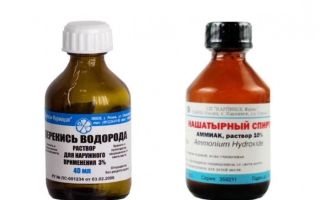Content
- 1 Advantages and disadvantages of hydrogen peroxide whitening
- 2 Features of whitening clothes with hydrogen peroxide
- 3 How to bleach clothes with hydrogen peroxide
- 4 How to enhance the effect of fabric bleaching with hydrogen peroxide
- 5 Hydrogen Peroxide Bleaching Precautions
- 6 Conclusion
- 7 Reviews of hydrogen peroxide whitening
Any housewife wants to achieve flawless whiteness of clothes at home. Keeping tablecloths, school shirts, baby linens, and kitchen towels perfectly clean is a rarity. Bleaching whites with hydrogen peroxide is a simple and proven effective way of achieving cleanliness over the years.
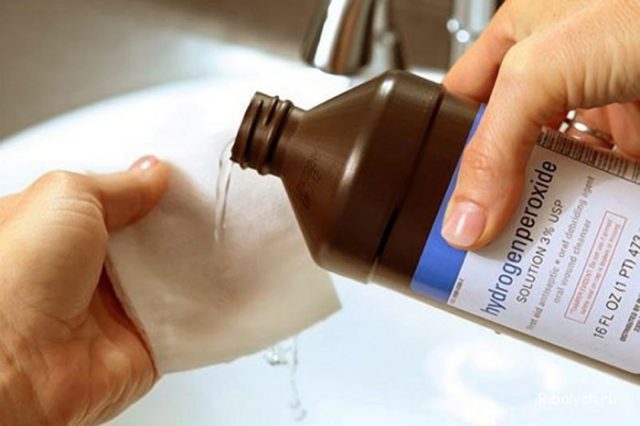
Advantages and disadvantages of hydrogen peroxide whitening
Benefits of hydrogen peroxide bleaching of white fabric:
- low cost;
- removal of old plaque and yellowness;
- ease of use;
- preservation of the structure of the material;
- application for delicate fabrics;
- returning the washed laundry to its original appearance;
- elimination of deodorant stains, sweat and oil;
- drug availability.
The only downside to hydrogen peroxide bleaching is the smell. Replace 1 tbsp. l. 3% peroxide can be 1 tablet of hydroperite. The action of the drugs is the same.
Peroxide is a readily available antiseptic. The drug is sold in any pharmacy in the country. For bleaching, use a 3% peroxide solution. The usual concentration of the composition: 2 tbsp. l. preparation for 10 liters of hot water.
Features of whitening clothes with hydrogen peroxide
White clothes look noble. But keeping it looking perfect for as long as possible is difficult enough. Light-colored laundry is quickly washed, acquires a yellow tint and loses its gloss. The use of hydrogen peroxide to remove stains from fabrics is associated with several features:
- When restoring the material, do not mix dark and light underwear in order to avoid shedding.
- Old yellow spots from wool and silk are removed in several stages. The clothes are placed in a peroxide compound diluted with water. After 30 minutes, the product is drained, the laundry is washed and dried. If contamination remains, the procedure is carried out the required number of times until the color is restored.
- Removing yellow stains from cotton and linen linen is carried out by directly applying a peroxide solution to the material. If the yellowness remains, the procedure is repeated until the contamination disappears.
- Bleaching is carried out only 1 time for 3-4 washes, otherwise the strength properties of the material will be lost.
- After bleaching, the clothes are rinsed in 2 stages: first at a temperature of 20-40 ° C, and then in cold water.
Each type of matter has its own recipe for whitening restoration. Therefore, during bleaching, things are separated not only by color, but also by the type of fabric: synthetics, silk and wool, or cotton and linen.
How to bleach clothes with hydrogen peroxide
With multiple washes, the white item turns gray and fades. To return the color saturation to the linen, a composition is prepared at the rate of ¼ glass of hydrogen peroxide per 5 liters of water with a temperature of up to 40 ° C. The laundry is left in the resulting mixture for 3 hours, then rinsed with vinegar or a balm for delicate natural fabrics
It is recommended to use a 3% peroxide solution when bleaching fabrics in the following ways:
- to get rid of old yellow spots, white clothes are soaked in the mixture for 1-2 hours;
- in order to avoid gray plaque on bedding, 1/2 cup of hydrogen peroxide is added to the automatic machine when washing linen;
- to restore the original color, white products are soaked for 1-3 hours in a solution;
- to bleach clothes from tea, coffee, wine, fruits, juice and blood, the composition is applied directly to the pollution.
How to bleach wool underwear with hydrogen peroxide
Dirt on white clothes from fabrics containing wool or silk is removed by hand washing. The solution is used to remove stains with hydrogen peroxide prepared from the following ingredients:
- 200 g of table salt;
- 25 g of detergent for delicate fabrics;
- 10 liters of water with a temperature of up to 30 ° C;
- 700 ml of 3% peroxide.

White clothes are placed in the prepared mixture for 3-5 hours. Then carefully take out the thing with pressing movements. The product is not pulled out, but everything is taken out at once, pressing with both hands. They draw warm water up to 35 ° C and rinse out the linen well with conditioner for delicate fabrics. The washed clothes are neatly laid out on a horizontal surface covered with a terry towel
Washing a downy shawl:
To return whiteness to downy products, add 2 tbsp to 10 liters of water at a temperature of 30-35 ° C. l. peroxide and place a shawl or scarf in the resulting mixture for 20 minutes. After washing, the product is rinsed with vinegar and hair conditioner.
How to bleach synthetics with hydrogen peroxide
White underwear made from thin synthetic material will wash and lose color over time. Bleach bras and panties with hydrogen peroxide. For this, underwear is soaked in the following composition:
- 10 liters of water with a temperature of 20-30 ° C are collected in the basin;
- bred with 3 tbsp. 3% hydrogen peroxide stirring;
- soak white underwear in the prepared product for 1 hour;
- the laundry is placed in an automatic machine, washed as usual, rinsed with an additional rinse function and dried.
Soaking white synthetic fabrics in a prepared peroxide solution for 30 minutes before the main wash will eliminate sweat odors from the laundry.
How to bleach white linen and cotton clothes with hydrogen peroxide
White linen and cotton products are bleached with a 3% peroxide solution, placing it during washing directly into the powder compartment of the automatic machine. Add 15 ml of peroxide to the cell at a water temperature of 65 ° C.
To whiten a T-shirt and jerseys, hydrogen peroxide is poured into a plastic bowl or bucket for 2 liters of water at a temperature of 40-65 ° C and 1 tsp is added. peroxide. White T-shirts are put into the resulting composition for 20 minutes. After that, the clothes are rinsed and dried.
If white knitted clothing has yellow spots, add 1 tsp to the resulting product. soda. This will give the product the lost whiteness.
How to bleach white socks with hydrogen peroxide:
How to enhance the effect of fabric bleaching with hydrogen peroxide
Hydrogen peroxide solution removes dirt on cuffs and collars and restores the look of gray, worn clothes. The following drugs help to enhance the effect of whitening of white tissues:
- ammonia;
- soda ash;
- lemon juice or acid;
- laundry soap.
This composition is used only for washing white items. It is impossible to remove stains on colored fabrics with this tool, since the combination of peroxide with other substances can lead to discoloration of the matter.
Peroxide and ammonia for bleaching
To get rid of gray plaque and yellowness on white fabrics and enhance the whitening effect, ammonia will help. For this, they recommend:
- In 5 liters of water with a temperature of up to 40 ° C, dilute 1 tbsp. l. peroxide and 1 tbsp. l. ammonia.
- Dip white clothes into the resulting solution and leave to soak for 30-50 minutes.
- After the time has elapsed, snow-white items are rinsed twice and washed as usual.
Bleaching of tulle with hydrogen peroxide is performed with a composition of:
- 10 liters of water, temperature 40-65 ° C;
- 2 tbsp. l. 3% peroxide;
- 1 tbsp. l. ammonia.
Tulle is placed in the resulting mixture, soaked for 5-10 minutes, rinsed thoroughly with warm and cold water.

To bleach a blouse or shirt, dilute 1 tbsp of water in 10 liters of water at a temperature of 40-70 ° C. l. ammonia and 2 tbsp. l. 3% hydrogen peroxide solution. The linen is dipped into the resulting composition for 20-30 minutes and rinsed thoroughly.
To ideally wash the cuffs and collars, they are pre-rubbed with laundry soap. This enhances the whitening effect.
Hydrogen peroxide and soda for bleaching clothes
A mixture of hydrogen peroxide and soda has an effect comparable in quality to professional bleaches. To restore the whiteness of the collars and cuffs, a paste is prepared from 10 ml of peroxide and 1 tsp. soda. The resulting composition is applied with a brush to the contaminated areas and left for 5-15 minutes. Then they are washed in an automatic machine with an additional rinse function.
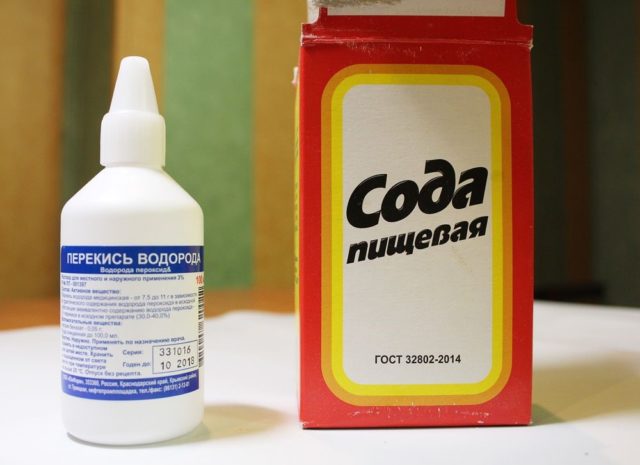
Bleaching white baby clothes and tea towels with hydrogen peroxide and baking soda gives excellent results. This mixture has worked well with housewives. For 2 liters of water with a temperature of 30 ° C add 1 tsp. peroxide and 1 tbsp. l. soda ash. White items are placed in the mixture for 10 minutes and washed in a daily manner.
White cotton and linen kitchen towels can be bleached using soda ash and peroxide, which are placed in the detergent drawer. At a temperature of 60-70 ° C, linen is washed as usual. Additional stain removers are not recommended with this method.
School white shirts are a hassle for housewives. Stubborn stains from sweat and deodorants, greasy marks from food, teal from a ballpoint pen - all this must be removed from the child's clothes. To whiten a blouse with hydrogen peroxide from sweat and yellow spots, a solution will help:
- 4 liters of water with a temperature of 40-70 ° C;
- 2 tbsp. l. soda ash;
- 2 tsp peroxide.
A shirt or blouse is lowered into the resulting composition for 15 minutes. After the lapse of time, things are thoroughly rinsed and dried.

Whitening with hydrogen peroxide and citric acid
A solution of lemon juice or acid and hydrogen peroxide is able to cope even with stains from fuel oil and diesel fuel on white things. To prepare the composition you will need:
- 2 liters of warm water;
- 1 tsp peroxide;
- 1 tsp citric acid.
White clothes with spots are soaked in the resulting composition for 10-15 minutes, rinsed well and washed.
Synthetic fibers react well to citric acid, which helps to delicately deal with dirt on white clothes. For this:
- Water is collected in the basin with a temperature of up to 40 ° C.
- Add 1 tsp. hydrogen peroxide.
- Squeeze the juice from ½ part of the lemon.
- Mix the composition thoroughly.
- Place the synthetic fabric for 20-30 minutes.
- Thoroughly rinse things first at a temperature of up to 40 ° C, and then in cold water.
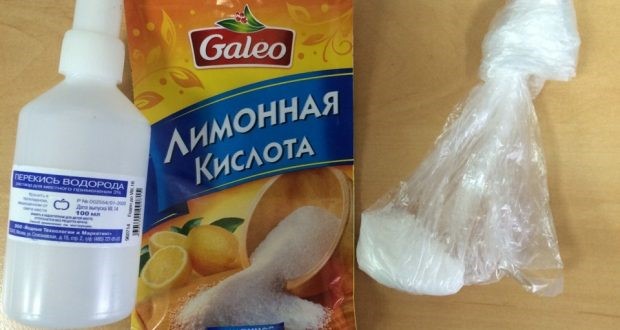
The resulting solution removes yellowness on white blouses. To do this, a mixture is applied to the places of contamination with a sponge and left for 30 minutes. If necessary, wash the whole thing with this mixture.
Light jeans are always problematic to bleach. A composition of citric acid and hydrogen peroxide will deal with stains on things. To do this, mix 1 liter of water with 1 tsp. citric acid and 1 tbsp. l. hydrogen peroxide. White jeans are soaked for 20-30 minutes. Wash with an extra rinse function.
If desired, apply this product from a spray bottle to the legs of colored jeans to lighten certain areas.
To achieve a snow-white effect on synthetic fabrics, the following composition is used:
- 5 liters of warm water;
- 1 tbsp. l. washing powder for delicate fabrics;
- 4 tbsp. l. table salt;
- 1 tbsp. l. hydrogen peroxide;
- 1 tbsp. l. ammonia.
Mix the ingredients well. White things made of synthetic fibers are dipped into the resulting solution for 2 hours. Rinse thoroughly 2 or more times.
Hydrogen Peroxide Bleaching Precautions
Removing stains with hydrogen peroxide on white items without protective equipment can cause burns.
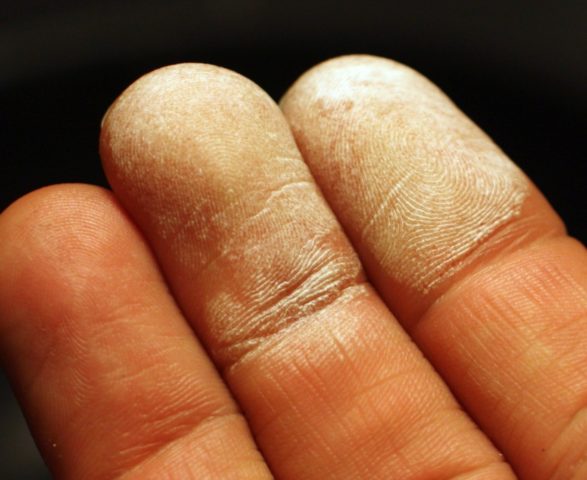
There are precautions to be taken:
- A paste of soda and hydrogen peroxide is applied to a white cloth for 10-15 minutes.
- Delicate items are soaked in warm water not exceeding 40 ° C.
- Commercial bleaches are not added to hydrogen peroxide solutions. Sharing can lead to an unwanted chemical reaction that can damage things or catch fire.
- Peroxide does not remove rusty stains on white clothes.
- It is recommended to work when mixing the compositions with rubber gloves to avoid getting burned.
- If the solution comes into contact with the eyes or mouth, a mucosal burn may occur. The affected areas are thoroughly washed with plenty of running water. If blisters begin to appear, they immediately consult a doctor for qualified help.
- At home, it is not recommended to use a hydrogen peroxide solution of more than 3%.
- It is necessary to work with peroxide only in ventilated areas to avoid poisoning.
- In order not to spoil the clothes, the product is first checked on a rag or on an inconspicuous area.
Conclusion
Bleaching of white clothes with hydrogen peroxide is widely used by housewives. It is an environmentally friendly product that releases oxygen upon reaction. Does not have compounds harmful to human health. Therefore, it is recommended to use it to remove dirt from baby clothes.

